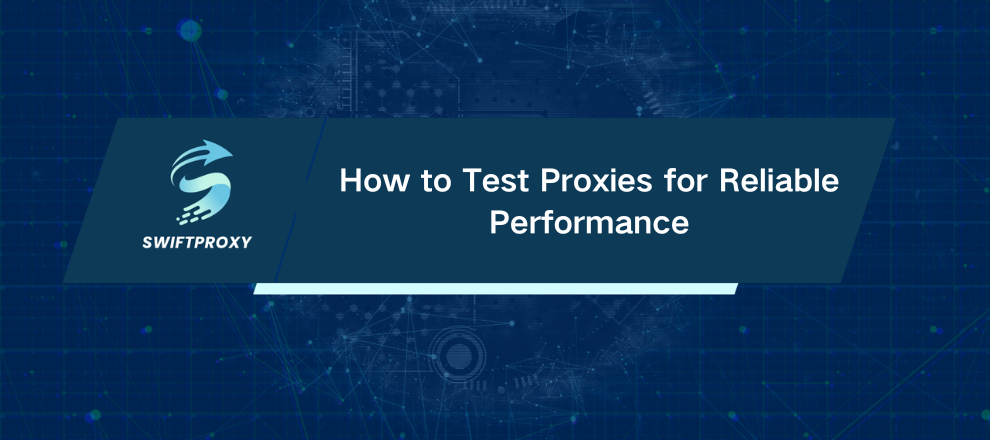How to Test Proxies for Reliable Performance

Proxy servers are the unsung heroes behind web scraping, marketing campaigns, cybersecurity, and countless automation tasks. However, not all proxies are created equal. A bad proxy can stall your workflow, cause data gaps, or even get you blocked. That's why testing proxies is non-negotiable if you want smooth, reliable operations.
Let's dive into how you can test proxies effectively. What tools should you trust? Which factors really matter? And how do you pick the right proxy provider for your needs?
What You Need to Test Proxies Efficiently
Testing proxies manually? Forget it. It's slow, technical, and downright tedious. Instead, arm yourself with the right tools that automate the process. Options range from command-line utilities to full-fledged proxy testing software and web services.
Don't stop at tools—set clear criteria to judge proxies. Measure speed, uptime, anonymity, and compatibility with protocols you rely on. These benchmarks will help you separate the winners from the weak links.
Tools and Techniques for Proxy Testing
IP Checkers
These reveal what IP address your proxy is exposing. Most online IP checkers show location, ISP, and browser info. Handy for a quick look—but they're limited. They can't tell you about proxy type or detect advanced flags.
IP Databases
These are treasure troves of IP info—geolocation, ownership, even blacklist status. Use reputable sources like IPinfo, IP2Location, or GeoIP2 to verify your proxy's legitimacy. Many websites cross-check these databases, so a mismatch can mean instant blocks.
FOGLDN Proxy Tester
A free desktop app that pings servers through your proxies and measures response times in milliseconds. Great for basic speed checks, especially if you're running high-frequency tasks. Downsides? It doesn't tell you much if a proxy fails, nor does it reveal proxy type or location. Use it as a quick litmus test, not a comprehensive solution.
Hidemy.Name
This service scales. Upload thousands of proxies in a CSV and get detailed reports on location, type, anonymity, and speed. The free plan is solid, allowing 100 proxies tested in batches. Paid plans lift restrictions and ramp up concurrency. If you're testing large proxy fleets, this is your friend.
Build Your Own
If you're comfortable coding, custom proxy testers offer ultimate control. Build a bot that routes requests through proxies, scraping sample data to confirm reliability and speed. Combine this with API access from services like Hidemy.name or IPinfo to validate proxies at scale.
What Really Matters When Testing Proxies
Location
Distance matters. The farther your proxy from your target server or yourself, the longer data takes to travel. This slows down connections and can impact tasks requiring real-time data. Also, check for geo-restrictions. Using a proxy in a restricted region won't help you access blocked content.
Speed
Latency kills. A slow proxy drags down browsing and scraping alike. For commercial applications, speed translates directly to efficiency and profit. Always benchmark proxies under your actual use conditions to avoid surprises.
Uptime
Downtime means lost opportunities. Aim for proxies boasting at least 99% uptime. Top proxy providers hit 99.5%. This requires good server maintenance and reliable hosting.
Choosing the Right Proxy Type
Residential Proxies
Tied to real IPs and physical addresses, residential proxies blend in naturally online. They're harder to detect and block, making them perfect for sensitive tasks like bypassing geo-blocks or avoiding bans. They're stable, anonymous, and ideal when privacy matters.
Datacenter Proxies
Fast and affordable, datacenter proxies offer tons of IPs on demand. Perfect for automation and large-scale scraping where volume trumps stealth. But they're easier to flag and block. Use them when speed and cost are your top priorities, but anonymity is less critical.
Final Thoughts
Testing proxies isn't a one-and-done task. It's a continuous process of validation, benchmarking, and adjustment. Choose ethical providers who source IPs transparently—like Swiftproxy, which ensures consent from all network peers. This commitment leads to higher quality proxies and healthier networks.
Now, go test your proxies with confidence. The right tools and insights will keep your operations sharp, fast, and reliable.

















































